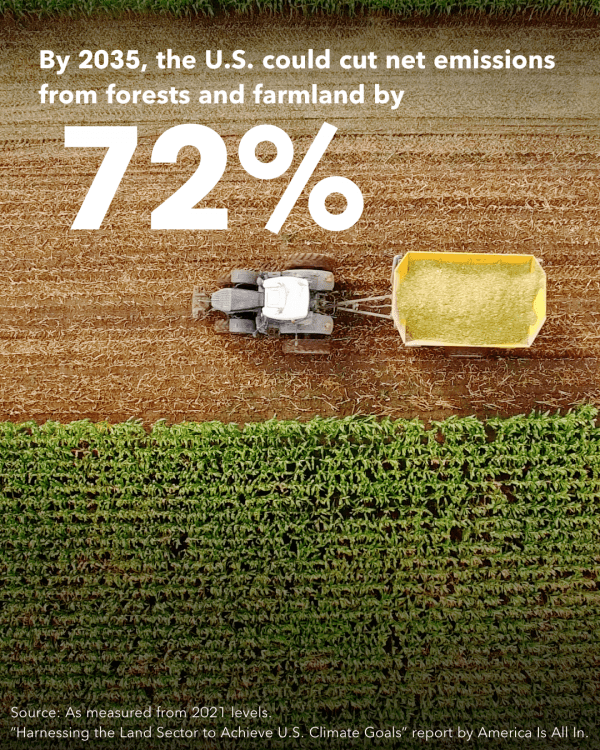New Analysis Shows Climate-Smart Agriculture and Forestry Investments Can Help Cut Net Emissions From Forests and Farmland by 72 Percent by 2035
America Is All In’s report outlines an ambitious pathway to reduce net emissions through a new Farm Bill that expands climate-smart investments, plus increased federal and state wildfire mitigation.
Professor and Associate Chair George Hurtt and Assistant Research Professor Lei Ma at the Department of Geographical Sciences led new carbon cycle modeling that was instrumental in the America Is All In report released today.
The report shows that by mobilizing and expanding climate-smart policies like those in the 2018 Farm Bill, the Inflation Reduction Act, and state reforestation programs, the United States could cut net emissions from forests and farmland by 72 percent by 2035 from 2021 levels–more than was previously thought possible. This would keep the U.S. on track toward its 2050 net-zero commitments and allow U.S. forests to continue to absorb more carbon than they release.
Led by the Center for Global Sustainability (CGS) at the University of Maryland, the “Harnessing the Land Sector to Achieve U.S. Climate Goals” report demonstrates that by implementing existing policies, the United States can deliver critical aggregate emissions reductions amounting to 89 MtCO2e from agriculture and forestry by 2035 compared to 2021 levels, with the biggest opportunities in Southern and Midwestern states.
“Smart land use policies are highly effective at reducing carbon emissions and fostering climate resilience,” added Michael R. Bloomberg, UN Secretary-General’s Special Envoy on Climate Ambition and Solutions, founder of Bloomberg LP and Bloomberg Philanthropies, and Co-Chair of America Is All In. “This report shows that by investing in our nation’s forests and farmland, we can accelerate America’s progress in reaching our climate targets, while also improving public health, creating good jobs, and saving lives. It's an idea that both parties should rally around.”
“We need to use every possible tool in our toolbox to cut our emissions and meet our climate goals, and that includes prioritizing the expansion of our carbon sink in this decade,” said Shannon Kennedy, the report’s lead author. “Our report offers the first-ever, initial look at how we can maximize today’s land use policies, including a new and enhanced Farm Bill, to accelerate emissions reductions from the agriculture and forestry sectors, while ensuring that the natural carbon sink absorbs more planet-warming pollution than it emits.”
Hurtt and Ma’s Ecosystem Demography (ED) model quantified the technical afforestation and reforestation capacities in U.S. forests, and provided the geospatial mapped estimates of that potential. Afforestation means planting trees on land that has not recently been covered with forest, while reforestation means planting trees on land that has been recently covered with forest.
Hurtt explained, “This information was used to validate the reports policy estimates for enhanced forest carbon uptake in the future, provide spatial information for those estimates, and lay out the larger context of additional opportunities that exist but have yet to be realized. The ED model has been extensively calibrated and validated with remote sensing observations and field data on U.S. forests. It is a key component of the NASA Carbon Monitoring System and is part of a global extension of the team’s pioneering work on forest carbon monitoring in Maryland.
The report underscores that the United States can enhance its carbon sink through the growth and expansion of the country's forests and ecosystems. However, this must be coupled with new actions to safeguard these vital eco-infrastructures and increase investments in climate-smart agriculture. Without such measures, climate-induced droughts and fires could significantly degrade this valuable sink by the 2030s, threatening climate stabilization goals.
Published on Wed, 01/24/2024 - 09:26


